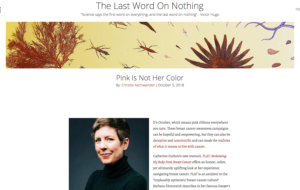Last week, I unleashed my (not so) inner feminist in an interview with Christie Aschwanden. Christie is not only a top-notch science writer but also a dear friend. She has written extensively about controversial topics in the breast cancer community. She is on #teamscience, which is not an easy team to play for these days. And, so, I deeply appreciate her inviting me to explore some complex ideas I’ve been grappling with these past few months, including how health care providers unintentionally perpetuate systems that harm breast cancer patients . When writing my memoir, FLAT, I aligned closely with the craft of creative nonfiction genre. I worked hard to stay rooted in the roles of character and narrator. Meaning, I didn’t expand my voice or my view beyond the scope of the story and direct connections to the story. So, in some ways, this Q&A with Christie was a welcome exercise as it allowed me to speak in a different register. I got to fully explore some complicated ideas and draw on inspiration I found in Susan Sontag’s essays. I hope you’ll take a look at the Q&A and let me know what you think.
. When writing my memoir, FLAT, I aligned closely with the craft of creative nonfiction genre. I worked hard to stay rooted in the roles of character and narrator. Meaning, I didn’t expand my voice or my view beyond the scope of the story and direct connections to the story. So, in some ways, this Q&A with Christie was a welcome exercise as it allowed me to speak in a different register. I got to fully explore some complicated ideas and draw on inspiration I found in Susan Sontag’s essays. I hope you’ll take a look at the Q&A and let me know what you think.
One Woman’s Story Can Change the World
Two weeks ago my investigative feature about surgeons violating breast cancer patients’ requests to go flat went up on Cosmopolitan.com. In the days following, my social media channels were inundated with #MeToo testimonies from breast cancer survivors as well as messages from readers and supporters who had no idea that women’s bodies were being abused and disrespected in this way. I have been buoyed by supportive messages, tweets, and posts. Thank you!!!
The highlight was an email I received yesterday from Dr. Patricia Clark, a nationally recognized breast surgeon in Arizona who was quoted in the piece. (For context: Dr. Clark travels the country teaching surgeons how to make women truly flat after mastectomy. She is my new hero.)
Dr. Clark gave me permission to share the email she wrote me:
Hi Catherine,
I thought you’d like to know…I was speaking at an international advanced oncoplastic surgery course over the weekend and your article was put up on the screen by the surgeon doing the opening introductory speech emphasizing respect for patient choice. It was presented and referenced several times during the conference with the photo of the patient [Kim] holding the sign demanding surgeon accountability…
My heart skipped a beat when I read her note. I was in my (parked) car. Rain pounded on the roof. A chill crept through my body as water soaked through my jeans, wet from dashing to my car through a downpour (the last gasp of Hurricane Florence as it moved through Massachusetts).
In my 20+ years as a women’s health journalist, I’d never felt more gratified than I did in that chilled, rain-soaked moment. I thought of Kim Bowles, the brave, badass woman who refused to go quietly. Of the hours she and I spent on the phone, trying to get the story right. Of the power of the media to shine a light of truth on women’s stories.
To amplify women’s voices so they were heard by a room full of international surgeons capable of affecting change on a global scale. To imagine even a single doctor who may feel compelled to listen closely, to attune to a woman’s voice, hear her autonomy, and respect her choice, made all I’ve been through as both a patient and a women’s magazine journalist worth it.
Thank you to those who trusted me with your stories: Kim Bowles, Becky Fitz, BethAnne King and so many more who shared their painful truths with me but, due to space limitations, weren’t named in the story. You are also my heroes.
Yesterday, Kim Bowles and I sat down for a joint interview about the Cosmo story and about my new memoir, FLAT. We spoke to the smart and engaging Megan Harris, the producer/director for The Confluence, 90.5 WESA, an NPR station in Pittsburgh, PA. (The interview was recorded, and I will post a link when it goes live.)
In the meantime, stay tuned for more news from me and Kim as we have some exciting things in the works!
The Beauty of Going Flat
Ten years ago, when I bucked four surgeons’ advice and decided NOT to reconstruct, I didn’t know a single other cis-gendered breast cancer patient my age who’d made that choice. I couldn’t help wondering “What was wrong with me?” that I craved simplicity rather than reconstruction. To feel the softness of a well-worn tee shirt against my skin? To use my back muscles to support my spine rather than to buffer an implant? To be set free from extra surgeries and screenings?
Nothing was wrong with me.
Today, I’m in the company of thousands of women who are reclaiming their bodies and their lives from cancer. Emily Hopper, 32, is a force of nature. She is a breast cancer advocate, an artist, and a mother.
“Not having breasts gives me a sense of freedom I never knew I wanted. In some ways it feels like a new level of womanhood,” Emily Hopper.
Emily is the owner-creator of EMPOWERHAUS, an online business whose mission is to embolden and inspire women, breast cancer patients, and supporters of all stripes. We met in an online community for “flatties” and became fast friends because she is wicked smart, hilarious, and ass-kicking.
Recently, we talked about living our best flat life for The Daily Beast. Take a peek and let me know what you think. And keep an eye on Emily cause this chick is going places!
1 in 3 Women Who Reconstruct Endure Complications
 This week, JAMA Surgery published the final results of the Mastectomy Reconstruction Outcomes Consortium (MROC) — the first comprehensive look at how cancer patients fare (physically and emotionally) after breast reconstruction. The New York Times had excellent coverage (aside from the cringe-inducing ending).
This week, JAMA Surgery published the final results of the Mastectomy Reconstruction Outcomes Consortium (MROC) — the first comprehensive look at how cancer patients fare (physically and emotionally) after breast reconstruction. The New York Times had excellent coverage (aside from the cringe-inducing ending).
Quick summary: MROC researchers looked at 8 different breast reconstructive procedures performed by 57 different surgeons at 11 sites across the US and Canada. They enrolled 2,224 patients and followed them for four years.
Last month, I spoke with Ed Wilkins, MD, MROC’s lead author and a plastic surgeon at the University of Michigan in Ann Arbor. “We designed and conducted MROC because the decision to reconstruct isn’t just one decision, it’s a constellation of decisions,” he said. “And our patients were getting lost.”
Flat and Proud
 I have zero tolerance for hiding. I came out to my father when I was 22. His response? “This can be our secret.”
I have zero tolerance for hiding. I came out to my father when I was 22. His response? “This can be our secret.”
Don’t worry — he and I have worked through it (hi dad!) — but his first reaction was to ask me to hide myself (to buy into my shame) to spare himself and others the discomfort of seeing my true self.
Fifteen years later, I was diagnosed with breast cancer, and I heard a hint of my father’s voice in the words of the plastic surgeon. He offered to reconstruct my breast by carving out a slab of my back muscle, wrapping it around my front, and tucking it over an implant, like a steak over a tennis ball. (Called a latissimus dorsi flap, the surgery is one of the most common reconstructive options after breast cancer.)
“Isn’t that back muscle doing something?” I asked.
“You’ll look normal in clothes,” he shrugged. “That’s all most women want.”
Really? Is that really ALL most women want?